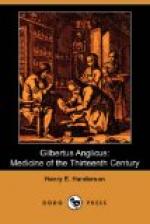Some of these names are still preserved in our nosologies of the present day; others will be recalled by the memories of our older physicians, and a few have totally disappeared from our modern medical nomenclature.
Interpolated fevers are characterized by intermissions and remissions, and thus include our intermittent and remittent fevers; synochus depended theoretically upon putrefaction of the blood in the vessels, and was a continued fever. Synocha, on the other hand, was occasioned by a mere superabundance of hot blood, hence the verse:
“Synocha de multo, sed synochus de putrefacto.”
Causon was due to putrefaction of bile in the smaller vessels of the heart, diaphragm, stomach or liver, and was an acute fever characterized by furred tongue, intolerable frontal headache, tinnitus aurium, constant thirst, delirium, an olive-colored face, redness and twitching of the eyes and a full, frequent and rapid pulse. Epiala and lipparia were febrile conditions concerning which there seems to have been much difference of opinion, even in the days of Gilbert. Apparently they were distinguished by variations of external and internal temperature, or by chills combined with fever. Febris ethica is our modern hectic fever. In the discussion of this last variety we are introduced to the “ros” and “cambium” of Avicenna, apparently varieties of hypothetical humors.
All these fevers are regarded from the standpoint of Humoralism, and depend upon variations in the quantity, quality, mixture or location of the four humors, blood, phlegm, bile and black-bile (melancholia).
In the general treatment of febrile diseases, so-called preparatives and digestives are first employed to ripen the humors, after which evacuatives (emetics, cathartics, sudorifics, and occasionally even venesection) are utilized for the discharge of these peccant humors. Much emphasis is laid upon the dietetics of fevers, and this branch of treatment is highly elaborated. Complications are met by more or less appropriate treatment, and the condition of the urine is studied with great diligence. Venesection is recommended rather sparingly, and is never to be employed during the dies caniculares (dog-days) or dies Aegyptiaci, nor during conjunctions of the moon and planets, nor upon the 5th, 15th, 17th, 25th, 26th, or 27th days thereafter, etc.
Among the complications of fevers discussed by Gilbert, two seem sufficiently important to justify special attention. On folio 74b we find a section entitled “De fluxu materie per parotidas venas,” in which he remarks that “Sometimes matter flows through the parotid veins behind the ears down to the neck and nares, and obstructs the passages for air, food and drink, so as to threaten suffocation.” He cautions us against the use of repressives, “lest the matter may run to the heart,” and recommends mollitives and dissolvents, such as butter, dyaltea, hyssop and especially newly shorn wool (lana succida), which, he says, is a strong solvent. Is this a reference to the septic parotitis not unfrequently seen in low fevers?




